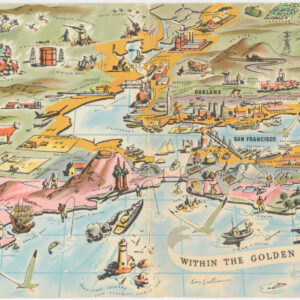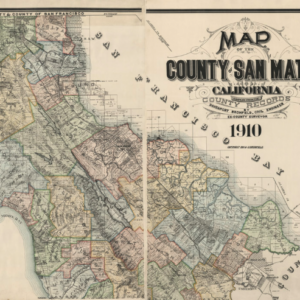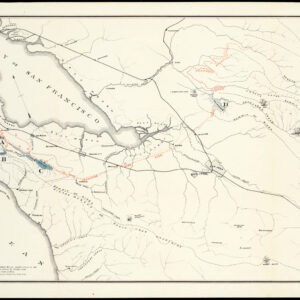One of the first maps of Oakland, with Alameda as a peninsula.
San Antonio Creek watershed and Oakland.
Out of stock
Description
This wonderful and rare hand-colored map constitutes one of the earliest dedicated depictions of the San Antonio Creek watershed and the associated town of Oakland. It was compiled according to the highest scientific and aesthetic standards of the day. For us, what is central to this map is a sense of the wetlands that were originally created by this watershed.
Among some interesting features on the map:
- Alameda, now an artificially-created island, is still shown as a peninsula.
- Today’s Lake Merritt is revealed to have been a larger inland bay draining out to the Bay.
- Oakland is largely covered by Oak Groves.
San Antonio Creek drains into the Bay across from San Francisco, which means that the map centers on the new settlement of Oakland. Slightly further to the east, we also find the township of Brooklyn, which was formed one year earlier. Little more than a village at this stage, Brooklyn was an amalgamation of two earlier settlements, Clinton and San Antonio. It was named for the ship Brooklyn that brought Mormon settlers to California in 1846.
The exquisite level of detail is maintained throughout so that all the individual elements are delineated clearly. The map is essentially topographical, showing not only the elevations of the hinterland but also depth soundings throughout the creek’s primary watershed. The rendition of the landscape is further enhanced with natural features such as the famous oak groves for which Oakland was named. Man-made features such as agricultural plots, roads and pathways, and even individual buildings (marked in black) are also clearly visible on this plan.
In Oakland, we see the city blocks and streets delineated, just as the new shipping wharves from 1852-53 depicted. The erection of these wharves coincided with the incorporation of Oakland as a town by the California State Legislature. The map also plots natural resources like the oyster banks just west of Oakland’s wharves.
The current chart meets the trinity standard for a great map:
- It is early and formative.
- It is accurate and detailed.
- It is aesthetically pleasing and would look great framed and displayed on a wall.
The accuracy aspect is closely related to the entity behind the map. The watershed chart was compiled under Alexander Dallas Bache’s direction shortly after Oaklands’s incorporation as a town and issued in 1858 by the Office of The US Coast Survey. The 1857 date cited in the map’s title refers to the year in which the surveys for this map were executed.
Created in 1807, the US Coastal Survey was the official chart-making branch of the government. It was initially founded in response to a dire need for better navigational charts of US coastlines, particularly its growing number of mercantile harbors. This need for better maps was already recognized during the War of Independence, so it is perhaps not surprising that the Survey was founded by President Thomas Jefferson (with the support of his Secretary of Commerce, Albert Gallatin). Originally dubbed Survey of the Coast, as seen in the title of this map, this office became the first scientific branch of the Federal Government.
We noted above that the chart was compiled under the supervision of Alexander D. Bache, who was the US Coastal Survey’s superintendent. From the subtitle, we may also glean some of the men involved in the actual survey work that went into compiling this map. This attributes triangulation to R. D. Cutts, topographical recording to A. F. Rodgers, and hydrography to a party under the command of James Alden.
Census
The OCLC only has a single listing dated to 1857 (no. 557366008), which is the year noted on the map. This is located in the British Library. An additional nine examples are listed under the correct 1858 date, the year of publication (no. 26612842). Holdings of the 1858 listing include the Oregon Historical Society, UC Berkeley, UCLA, UC San Diego, The California Historical Society, and Stanford University Library. These are the same map.
Cartographer(s):
Alexander J. Bache was an American physicist, chemist, and cartographer from Philadelphia. He was the great-grandson of Benjamin Franklin.
Bache was known for conducting detailed surveys of the American coastline. He was originally an army engineer and was behind the establishment of a number of coastal fortifications, including Fort Adams in Newport, Rhode Island. He later became Superintendent of the United States Coast Survey and built it up into one of the world’s most modern and efficient cartographic institutions in the years leading up to the Civil War.
During the Civil War, Bache spearheaded a monumental effort to compile and collate the latest survey data so that new and more accurate charts could be drawn to aid the war effort. Bache also worked as a professor of Chemistry and Natural Philosophy at the University of Pennsylvania.
Lang and Laing Office of the Coast SurveyThe Office of Coast Survey is the official chartmaker of the United States. Set up in 1807, it is one of the U.S. government’s oldest scientific organizations. In 1878 it was given the name of Coast and Geodetic Survey (C&GS). In 1970 it became part of the National Oceanic and Atmospheric Administration (NOAA).
The agency was established in 1807 when President Thomas Jefferson signed the document entitled “An act to provide for surveying the coasts of the United States.” While the bill’s objective was specific—to produce nautical charts—it reflected larger issues of concern to the new nation: national boundaries, commerce, and defense.
Alexander Dallas Bache, great-grandson of Benjamin Franklin, was the second Coast Survey superintendent. Bache was a physicist, scientist, and surveyor who established the first magnetic observatory and served as the first president of the National Academy of Sciences. Under Bache, Coast Survey quickly applied its resources to the Union cause during the Civil War. In addition to setting up additional lithographic presses to produce the thousands of charts required by the Navy and other vessels, Bache made a critical decision to send Coast Survey parties to work with blockading squadrons and armies in the field, producing hundreds of maps and charts.
In 1871, Congress officially expanded the Coast Survey’s responsibilities to include geodetic surveys in the interior of the country, and one of its first major projects in the interior was to survey the 39th Parallel across the entire country. Between 1874 and 1877, the Coast Survey employed the naturalist and author John Muir as a guide and artist during the survey of the 39th Parallel in the Great Basin of Nevada and Utah. To reflect its acquisition of the mission of surveying the U.S. interior and the growing role of geodesy in its operations, the U.S. Coast Survey was renamed the United States Coast and Geodetic Survey (USC&GS) in 1878.
Condition Description
Excellent. Lower left margin completed with archival tissue paper.
References



